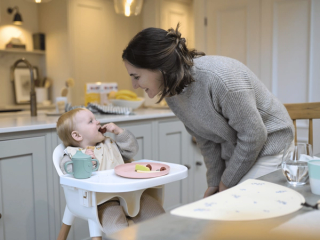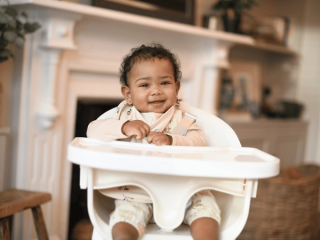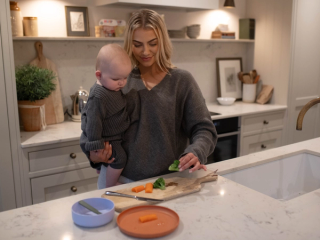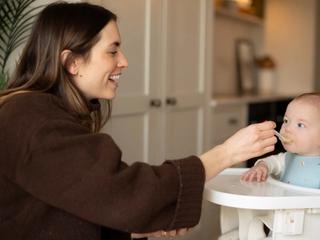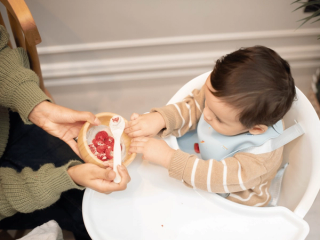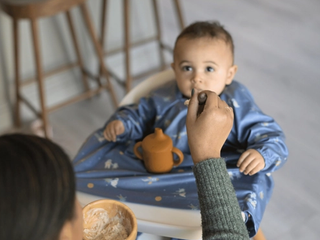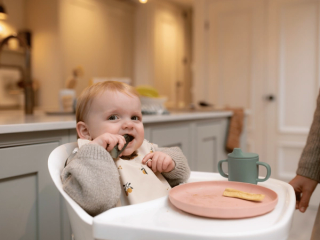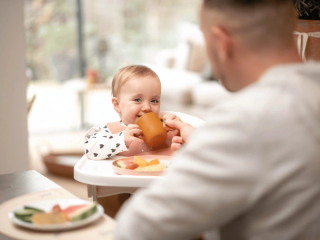
- Home
- Advice Hub
- Baby
- Weaning
- Portion Sizes And Self - Regulation
Portion sizes and self-regulation
There are no set portion size guides for babies. This is because all babies eat different amounts to each other and because the amount they eat will vary from meal to meal and day to day.
Portion sizes for babies
There are no set portion size guides for babies. This is because all babies eat different amounts to each other and because the amount they eat will vary from meal to meal and day to day.
It is recommended that you avoid focusing on how much your baby eats – though we know how difficult that can feel at first. We tend to have preconceived ideas about how much babies should eat, or worry if babies only eat tiny amounts, but try not to! Try to think about variety over volume. How much variety your baby gets throughout their weaning journey is more important than how much they eat at each meal.
Your baby knows how much to eat
Maybe you will feel more comfortable with your baby eating different amounts each time if you know that babies are born knowing how much they need to eat. When we let them take charge of the process without getting involved ourselves, they tend to do it very well, but they do it across a number of days rather than meal by meal. In practice this means that some days they’ll eat more, others less. During growth spurts they’ll be particularly hungry, when they’re ill they might eat less, but afterwards the appetite will increase to make up for it.
This process is called ‘self-regulation’ and describes the process of babies regulating their food intake to ensure that they are growing properly.
How do we know they can do this? Breastfeeding is a great example. Even the tiniest of newborns will indicate that they are hungry by rooting around for the breast or crawling on the chest during skin to skin with Mum. They feed until they are full and then when they have had enough, they just stop. They unlatch from the breast or they fall asleep. Either way, they tend to be happy and content, which tells us that they’ve had enough to eat.
Breastfeeding is a perfect example of hunger and fullness as we have no idea how much milk they are taking each time, so we have to put our trust in the process and in our baby’s cues. Bottles are slightly different because we can see how much milk has been taken – for this reason parents tend to get into the habit of thinking in ounces or mls and encouraging babies to finish if they have some left. When we can’t see, there’s nothing to go on except the cues our baby communicates with. It’s good to think about solids in the same way as a breastfed baby. Just let your baby tell you with their actions when they are full.
How can you tell if your baby is eating enough?
If trusting cues doesn’t feel enough to go on, there are other things to look at too.
Are they growing well? Make sure you have your baby weighed and check that they are following their growth curve; if they are then you know that they are eating the right amount.
Are they satisfied after meals? It doesn’t really matter whether your baby eats a few mouthfuls or a whole bowl of food. The most important thing is that they are happy and satisfied with the amount that they have eaten, and there is no encouragement to eat more or stopping before they are satisfied.
Listening to your baby’s cues
Mealtimes
As parents, it’s our job to learn our baby’s cues, which at first can feel like an impossible task. When it comes to feeding, we need to look out for both hunger and fullness cues. All babies will communicate in slightly different ways; but some signs of fullness include:
- clamping mouth shut
- turning head away from the spoon
- getting upset
- throwing food
- wanting to get out of the high chair
As soon as your baby indicates they are finished, it is best to finish the meal for them and get them out of their chair. This way you finish on a positive and your baby is more likely to come back to their next meal with enthusiasm.
Milk feeds
If you are bottle feeding you can still help your baby to listen to their body by treating the bottle as if it were a breast. Instead of looking at the amount that your baby has taken look at the way that they feed. If they tell you they want to stop by pushing the bottle out, closing their mouth, turning their head away or becoming upset you should simply stop the feed and take the bottle away. The more you keep going back to it and encouraging your little one, the less able they will be to listen to what their body is telling them.
It is also fine if every bottle is drained with enthusiasm! If the bottle is drained and your little one is content then you don’t need to add more. However, if on multiple occasions the bottle is being drained and your baby still seems unsettled or searching for more you can increase the volume a little. An ounce or 30ml is plenty to increase by each time.
For the first few months of weaning, milk is still the primary source of nutrition so you should continue to offer your baby’s usual milk feeds alongside the meals that you offer.
Advice & tips

Want to read more? Join the HiPP BabyClub for full access to this article.
As a BabyClub member, you'll get access to a range of exclusive benefits, including:
Monthly competitions
Discounts from our Partners
Expert advice tailored to your little one's age
Weaning recipes
HiPP shop discounts*
*10% off HiPP's online shop does not apply to our First Infant, Anti-Reflux or Comfort Formula Milk.
Important notice: Breastfeeding is best. Follow on milk should only be used as part of a mixed diet from 6 months. Talk to a healthcare professional.




